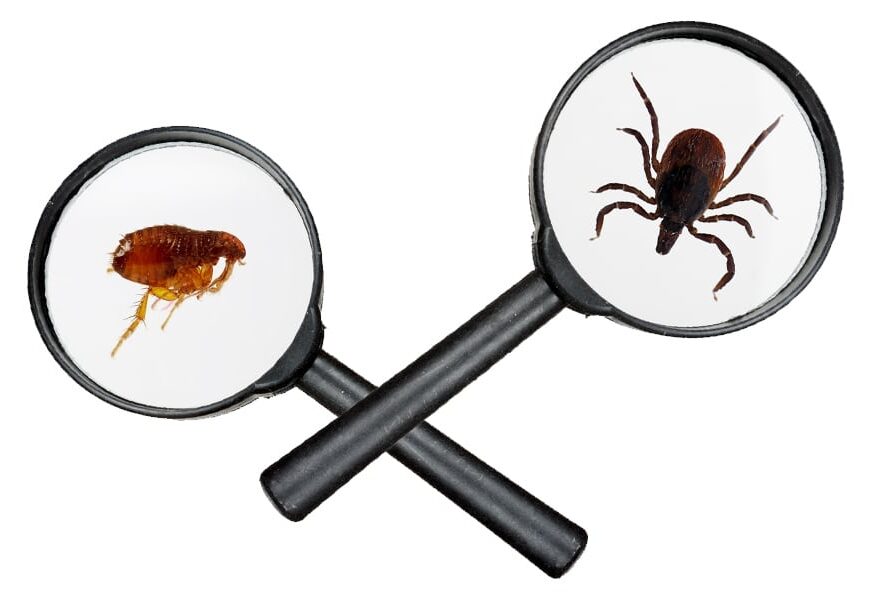Warmer weather means we can all go outside again and enjoy the great outdoors. It kicks off a time of hiking, barbeques, and family get-togethers. However, this also means tiny little devils could also be lurking and trying to ruin your good time. Yes, we are talking about fleas and ticks.
These little nuisances are often found on your furry little companions. They can be just as detrimental to you and your family as they can be to your pets. Elimination and prevention of fleas and ticks is the goal, but first, let’s look at the key differences between the two pests.
What Are Fleas?
Fleas are wingless insects that like to feed on blood. They are jumpers with incredible verticals and like to travel by jumping from objects to pets. A fully mature flea measures from 1/16 to 1/8 of an inch in length. The younger fleas are much smaller and far more challenging to locate. These wingless pests are not picky and will feed on any source of blood they can find – dog, cat, or even you!
A typical flea has a lifespan of around 100 days. They prefer warm temperatures, so a pet’s fur is the perfect place for them to hide. They lay 20 to 40 eggs per day, attaching them to the animal’s hair. So anywhere a pet sheds its hair has the potential for transmitting fleas. Fleas will infest your home’s carpet, hardwood, and furniture. The dangers of fleas can come in the form of tapeworms and Bartonellosis.
If you spot fleas on your pet, you will want to get rid of them as soon as possible. You can do this by using a flea shampoo or dawn dish soap to wash your pet. As you lather the soap into the fur, it should kill the fleas. Upon rinsing, you will see many fleas fall off your pet. You may need to perform multiple washes to get them all, depending on the severity of the infestation. If a bath causes anxiety for your pet, you can gently use a flea comb to remove the fleas.
What Are Ticks?
Ticks differ from fleas because they are more closely related to arachnids than insects. That is not where the differences end. Ticks are slightly larger than fleas at about ¼ of an inch in length. They are not jumpers, but this does not stop them from finding their way to their next meal. Like fleas, ticks feed on any blood they can find – dog, cat, lizard, snake, or even you!
Tick’s lifespans can be anywhere from 3 weeks to 3 years. Throughout their life, a tick will travel from host to host. They do not mind the cold, so they are found year-round. A female tick will feed and lay thousands of eggs, potentially causing a significant infestation. Ticks also come in many species and will transmit some hazardous illnesses like Lyme disease and Rocky Mountain Spotted Fever.
If you find a tick embedded in your pet or your skin, it is essential to know how to remove it safely. Using tweezers, pinch the tick as close to the skin as possible, removing the entire tick, not just the body. Use even pressure and pull the tick straight up, avoiding twisting motions. If the tick moves once removed, you will know that you got the whole thing. Once the tick has been removed, dispose of it properly. Wash the area thoroughly with soap, water, or alcohol to prevent infection.


How Do You Deal with an Infestation?
The best way to treat a flea or tick infestation is to prevent it from happening. This means using year-round preventative measures on your dog or cat. There are several products on the market designed for your pet to repel these pests. Only use dog products on dogs and cat products on cats!
Also, be on the lookout for new symptoms your pet might display. This could help you identify a potentially harmful disease or illness your pet has picked from a bite. Contact a local veterinarian if you notice any of these symptoms: hair loss, skin inflammation, itching, fatigue, weakness, pale gums, fever, swollen joints, poor appetite, lameness, painful muscles or joints, bleeding problems, depression, or signs of a tapeworm infection
Last but not least, doing a quick scan of yourself, your family, and your pets after you get done exploring the great outdoors can prevent you from bringing unwanted pests home with you.
Fleas and ticks pose serious health threats. Knowing them and how they think will help you create a plan of action to keep them at bay. They are tiny, but they are fierce. You must protect yourself, your family, and your pets.
At Emtec Pest Control, we are committed to safe and responsible pest control. We understand that your family’s safety is your number one priority, so we make it our priority, too.
If you have any other questions about any of these pests or pest control for your home or business, contact your Oklahoma pest control experts at Emtec Pest Control by calling us or by filling out our online contact form.

